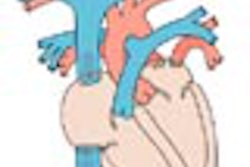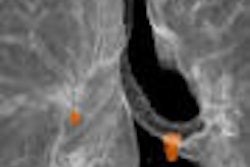The evolution of modalities used in the practice of radiology, from 3-tesla MR units and 64-slice CT systems to the latest generation of hybrid PET/CT and SPECT/CT technologies, is fast producing a daily volume of images that threatens to overload the capacity of interpreting radiologists, according to a presentation at the Society for Computer Applications in Radiology (SCAR) annual meeting in Orlando, FL, last month.
"Many people are projecting that this might be the most important crisis to face radiology today," said Dr. Eliot Siegel, professor and vice chairman of information systems in the department of diagnostic radiology at the University of Maryland School of Medicine in Baltimore.
As the number of images to be interpreted on a daily basis has increased, the radiology community has evolved its strategy for handling the workflow. Back in the day, about 10 years ago according to Siegel, film-based interpretation utilizing alternators and viewboxes was the norm. As image volume began to increase, static soft-copy workstation-based image interpretation delivered via PACS gained traction.
Dynamic image interpretation became the next strategy for image-volume workflow, closely followed by the use of stack-mode workflow schemas, which increased interpretation efficiency as well as accuracy, Siegel said. Linked stack mode, an enhancement that synchronizes multiple stacked images within an examination or across a current exam and prior exams, has found great favor with radiologists.
Tipping point
However, the rapid transition to multislice CT in the U.S. has outpaced the interpretation capabilities for the amount of images generated by these systems. Siegel noted that current workflow reading approaches are inadequate for reviewing the 300 to 500 images acquired during a routine CT of the chest, abdomen, or pelvis, and is less so for the 1,500 to 2,000 images generated during a CT angiography "run-off" study. This is also the case for complicated MR procedures such as functional studies, and even general radiography studies have become more complex, he said.
The most commonly used strategy to cope with this volume is to acquire images using thin collimation and then reconstruct the images using thicker sections, such as 5- to 8-mm slices. The result is a three- to tenfold reduction in the number of images pushed through the PACS, which would seem to provide a satisfactory solution.
In clinical practice, however, this has provided a less than acceptable resolution to the problem. For example, Siegel said that his institution is seeing 1,000 to 2,000 images per CT trauma scan, with some upwards of 4,000 images. Because of the reconstruction applied to the images, he said that it is taking upward of 10 minutes to send the dataset from the CT to the PACS, which is often longer than it took to perform the scan.
Also, by taking thin slices and creating thick slices, this negates the added value and power of the new generation of scanners. In addition, the amount of time spent by technologists in performing these reconstructions is unacceptable, according to Siegel.
"It requires a large amount of additional technologist time, especially for angiographic rendering, analogous to the extra time required for technologists to produce films in multiple window/level settings," he said.
The best view
Instead, Siegel recommends using volumetric navigation as a workflow strategy for radiologists. He believes that volumetric navigation and multiplanar and 3D imaging will allow radiologists to take the process of image review and separate it from the manner in which images were acquired and reconstructed.
"Volumetric navigation frees the radiologist from the limitations of fixed-slice axial images," he noted.
For example, a spine image could be interactively rendered and reviewed as a sagittal or coronal dataset at any slice thickness. Long nodules could be visualized with thicker slices, 15-20 mm, with a maximum intensity projection (MIP)-enhanced view in the axial plane. Colons could be depicted in the coronal plane, while the liver and spleen could be reviewed in the axial plane.
"Radiologists should have the flexibility from case to case to determine whether the images should be reviewed in the sagittal or coronal or any oblique plane in any slice," he said.
New tools, new issues
Although the use of volumetric navigation has tremendous potential for enhancing productivity and accuracy, the adoption of the technology poses some challenges, according to Siegel. One concern is that radiologists may be trading image volume overload for clinical image content overload.
"Our abdominal and thoracic subspecialists have asked whether they are now responsible for detailed reports of the musculoskeletal system and spine and of the individual vessels now visualized on a routine body CT study," he said. "Should they specifically and routinely comment, for example, on the renal arteries, aortic and iliac arteries, and superior and inferior mesenteric arteries?"
The routine use of 3D navigation may also have implications on the time required to dictate a study, Siegel noted. On the business side, the technology creates billing issues, as a single exam can now generate the equivalent of multiple subspecialty studies. From an information technology standpoint, workstation hardware may need to be upgraded to better support 3D applications, and user-input devices, such as mice, may need to be exchanged for more efficient navigation controls, such as joysticks.
"Although image navigation and enhancement will continue to improve, including better support for multimodality fusion such as PET/CT, the next major phases of interpretation will focus on decision support tools, such as computer-assisted diagnosis, queueing, and the intelligent application of informatics," he forecast.
By Jonathan S. Batchelor
AuntMinnie.com staff writer
July 11, 2005
Related Reading
Sophisticated 3D volumetric imaging has a place in everyday orthodontics, July 4, 2005
3D offers speed gains for fetal scanning, July 1, 2005
Start-up 3DR aims to outsource 3D processing, July 1, 2005
How to find and train a 3D technologist, June 17, 2005
Integrated 2D/3D offers workflow, clinical gains, June 17, 2005
Copyright © 2005 AuntMinnie.com



















